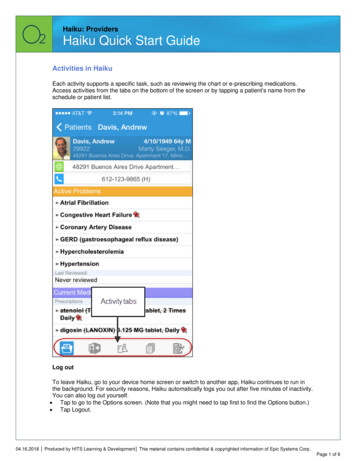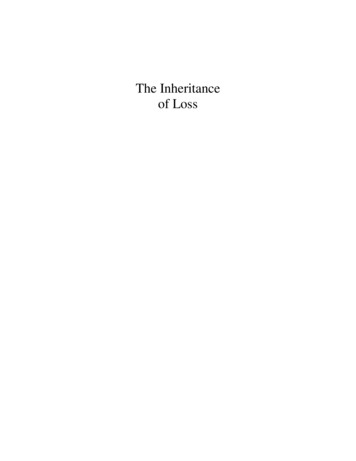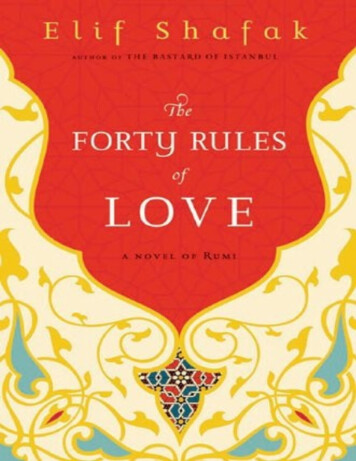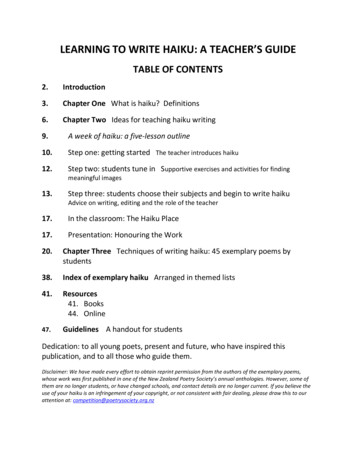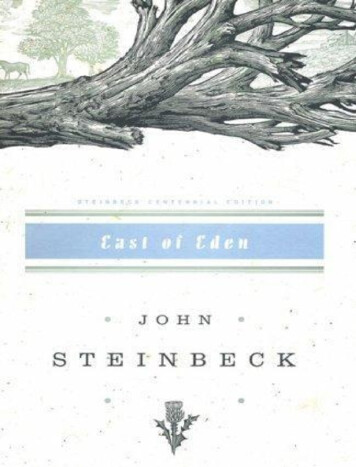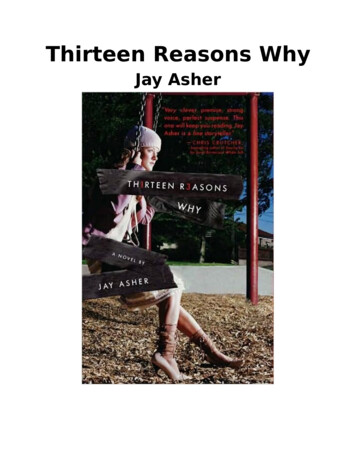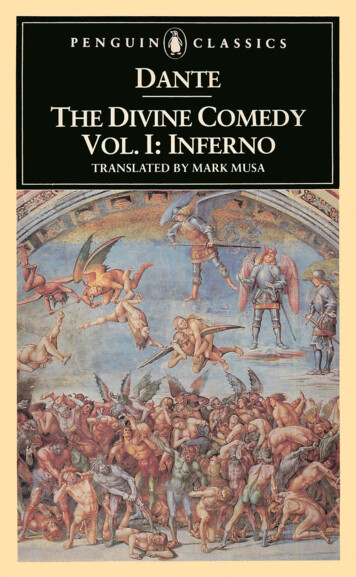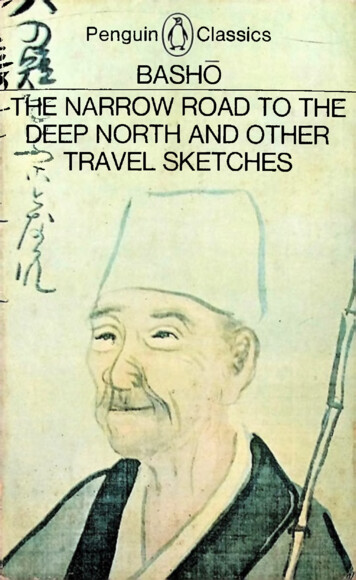
Transcription
t.PenguinClassicsifwftrBASHO-TlgE NARROW ROAD TO THE* DEEP NORTH AND OTHER t? TRAVEL SKETCHES
i
ITHE PENGUIN CLASSICS *FOUNDER EDITOR (1944-64): E. V. RIEUPresent Editors:BETTY RADICE AND ROBERT BALDICK
i
BASHOTHE NARROW ROAD TOTHE DEEP NORTHAND OTHER TRAVELSKETCHESTranslated from the Japanesewith an introduction byNOBUYUKIYUASAPENGUIN BOOKS
Penguin Books Ltd, Harmondsworth, Middlesex, EnglandPenguin Books Inc., 7110 Ambassador Road, Baltimore, Maryland 21207, U.S.A.Penguin Books Australia Ltd, Ringwood, Victoria, AustraliaThese translations first published 1966Reprinted 1968, 1970Copyright Nobuyuki Yuasa, 1966Set in Monotype Bcmbo byRichard Clay (The Chaucer Press) Ltd,Bungay, Suffolkand printed in Great Britain byFletcher & Son Ltd, Norwich, NorfolkThis book is sold subject to the conditionthat it shall not, by way of trade or otherwise,be lent, re-sold, hired out, or otherwise circulatedwithout the publisher’s prior consent in any form ofbinding or cover other than that in which it ispublished and without a similar conditionincluding this condition being imposedon the subsequent purchaser,
CONTENTSAcknowledgementsIntroduction79THE RECORDS OF A WEATHER-EXPOSED SKELETON51A VISIT TO THE KASHIMA SHRINE 55THE RECORDS OF A TRAVEL-WORN SATCHEL71A VISIT TO SARASHINA VILLAGE9iTHE NARROW ROAD TO THE DEEP NORTH97Map 1. Central Japan145Map 2. Central Japan146Map 3. Northern Japan147Notes149
u r'
ACKNOWLEDGEMENTSTo translate from one language into another is a fearsome task.It is a fitting punishment for that human pride which led to thegreat confusion of languages. When the present work was but be gun some three years ago, a friend of mine who happened to seeme labouring over it, remarked in an innocent manner that I wasattempting an impossibility. When the work was a little moreadvanced, a more sympathetic friend questioned whether I hadthe same command of English as Basho did of the language inwhich he wrote. It is, therefore, with a great deal of humility andself-reproach that I am now sending the work to the press.Through the years of assiduous work, however, I have beenaided by a number of people. My deepest gratitude goes to MrGeorge James Moor who kindly took the trouble of reading mymanuscript at different stages of its growth, always providing mewith valuable suggestions not only on grammar but also on deli cate points of style and composition. Without his help, it is mostcertain that the present work would never have gained its form.I am also indebted to Professor Kinjiro Kaneko, Professor TadashiIwasa, Professor Takeshi Morita and Assistant Professor KeijiInaga for giving a greater degree of accuracy to my work bychecking the names and dates with their experienced eyes. I amalso grateful to Mr Rihei Okada, director of the Itsuo Museum,Ikeda City, Osaka, for kindly permitting me to use the portraitof Basho and the illustrations in the text. Finally I must thank MrsBetty Radice of Penguin Books Ltd and Mrs Nina Froud ofHarvey Unna Ltd for their kind co-operation.Hiroshima 1965NOBUYUKI YUASA7
INTRODUCTIONHaiku, or hokku as it was called during the lifetime ofBash5, is the shortest among the traditionally acceptedforms ofJapanese poetry. It consists of seventeen syllables,1divided into three sections of fivc-scvcn-fivc. For example,FurUike ya, kawazu tobikomu, ntizu no oto.Breaking the silenceOf an ancient pond,A frog jumped into water A deep resonance.2It is obvious, however, that it is not sufficient to definehaiku purely from the standpoint of syllabic structure, forhaiku, like any other form in literature, has grown out of along process, and it is subject to a number of restrictionshistorically imposed upon it. Let me, therefore, attempt byway of introduction a short history of haiku so that thereader may get acquainted with the essential traits of thismost fascinating literary form.Long before haiku, or even its distant prototype, cameinto existence, there was already an established form ofpoetry in Japanese literature, and this form, waka, consistedof thirty-one syllables, divided into five sections of fiveseven-five-sevcn-seven. For example,Haru no no ni, sumire tsumi ni to, ko shi ware zo,no o natsukashimi, hitoyo ne ni keru.Coming with a light heartTo pick some violets,9
IntroductionI found it difficult to leaveAnd slept overnightHere in this spring field.3Or again,Hisakata no, hikari nodokeki, haru no hi ni,shizugokoro tiaku, hana no cliiru ratntt.On a long spring day,When all is happily bathedIn the peaceful sun,Cherry blossoms alone fall Unwilling to stay?4As these examples indicate, this older and longer form ofJapanese poetry was particularly suited for emotive ex pression and refmed description of nature. Hence it becameextremely popular among aristocratic courtiers. Courtiers,however, employed this form sometimes in their playfulmood as a medium of witty conversation, breaking it intotwo separate halves of five-seven-five and seven-seven.For example,Okuyama ni,fune kogu oto no, kikoyuru wa.Nareru kononti ya, umi wataru rarnu.How is it that I hearThe noise of creaking oarsIn the deepest mountains?Because of the ripening fruitsThat rub against wood as oars do.5io
IntroductionOr again,Ilitogokoro, ushimitsu ima wa, tanoma ji yo.Yutne ni miyu ya to, tie zo sugi tti kern.It has passed midnight,I no longer wait for you,Pining for sorrow.Oh, dear, I overslept,Wanting to sec you in the dream.6Sometimes the order of the two halves was reversed to givemore independence to each counterpart and greater free dom to the exercise of wit. For example,Ta ni hamii korna wa, kuro ni zo ari kern.Nawashiro no, mizu ni wa kage to, mic tsure do.The horse grazing on the bankSeems to me black in colour.I think it otherwise,For its reflection in the paddySays chestnut-brown.7This kind of witty verse, which continued to be writtenunder the name of linked verse (renga) throughout theHeian period (794-1191), seems to me to be the earliestgerm of haiku poetry, for it is here that for the first timethe fivc-scvcn-five syllabic structure came to be recognizedas a poetic unit, though not completely independent, andfurthermore, the witty and playful tone of the linked verseis a heritage which passes into the marrow of later haiku,though somewhat modified by subsequent developments.Towards the end of the Heian period, and more11
Introductionuniversally in the Kajnakura period (1192-1392), arose thefashion of writing a long chain of linked verse by multi plying the number of links. For example,Nara no miyako 0, omoi koso yarc.Yaezakura, aki no momiji ya, ika nara mu.Shigururu tabi ni, iro ya kasanaru.I wonder how it is nowIn the ancient capital of Nara.Those time-honoured cherriesThat bloom in double flowersMust be in their autumnal tints.Each rain of fall brings forthEver-deepening colours in the leaves.8In the beginning, the number of poems thus linked to gether was relatively small, but before long as many asthirty-six, forty-four, fifty, or even one hundred poemsbegan to be included in a series. What must be borne inmind in reading these long sequences of linked verse is thatthey were written by a number of poets sitting together andwriting alternately, and that each poem in a series waslinked to the immediately preceding one either by wittyassociation or verbal play. The result was often a kind ofkaleidoscopic beauty with infinite variety revealed to thereader in a slowly evolving movement.Inherent in these long sequences oflinked verse, however,was a danger that they might degenerate into chaotic con fusion or tedious monotony. To prevent this, therefore,various attempts were made to establish certain rules of12i
Introductioncomposition, and various schools of poets began to beformed. During the Kamakura period, these schools wereclassified roughly into two groups, serious (ushin) and nonscrious (mushin), the former trying to emulate the elegantstyle of waka and the latter persisting in witty compositionof a lower order. Towards the end of the Kamakura periodand during the Muromachi period (1393-1602), however,the poets of the serious group won gradual ascendancy,and with the coming of Sogi (1421-1502) the art of linkedverse reached its perfection. Let me quote here the firsteight poems of his masterpiece called Minase Sangin as anexample of his superb art.Snow-capped as they are,The gentle slopes of the mountainsFade into the hazy mistAt twilight on a spring day.The river descends far and distant,Plum-fragrance filling the village.In a soft river breezeStands a single willow treeFresh in spring colour.At early dawn every push of the oarIs audible from a passing boat.There must be a moonDying in the morning skyWrapped in a heavy fog.The ground is covered with frost,The autumn is drawing to its close.13
IntroductionIn a sorrowful voiceA cricket is heard singingBeneath the withering grass.I paid a call to a friend of mine,Taking a desolate lane by the hedge.0Note in the above how each poem takes up the suggestionof the preceding poem and yet opens a new world of itsown, so that the reader is carried through the whole seriesas through the exquisitely arranged rooms of a building,always entertained by delightful changes but never arrestedby sudden contradictions. It is no longer witty associationor verbal play but something in the depths of the humanheart that combines these poems. I think it is particularlysignificant from our point of view that already in the timesof Sogi, the starting piece (hokku) of a series, which wasalways written in the five-seven-five syllable form, wasgiven a special place and composed only by the most ex perienced of the poets. At least two things were consideredessential to the starting piece. First, a reference to theseason in which it is written, and second, the existence ofthe so-called breaking word (kireji), a short emotionallycharged word which, by arresting the flow of poetic state ment for a moment, gives extra strength and dignity.These arc restrictions that bind later haiku as well.Towards the end of the Muromachi period and in theearly part of the Edo period (1603-1866), linked verse of alower order (haikai no renga), which continued to be writtenin the preceding age merely as a kind of recreative pastime,gained enormous popularity. This is, of course, partly dueto the over-refinement and elaboration of serious poetry,14
Introductionbut mainly because freedom and open laughter, whichcharacterized linked verse of a lower order, suited the tasteof the merchant class which was then rising throughoutthe country. The earliest innovators are Sokan (dates un known) and Moritakc (1473-1549). Let me quote here someof their poems (hokku) to give a glimpse of their poeticworld.In a perfect circleRises the spring day.But it gains an enormous lengthBy the time it sinks.To the moon in the skyIf you put a handle,It will certainly beAn excellent fan.A hangmg willowIn beautiful greenPaints eyebrowsOn the brow of a cliff.Not in the flowerBut rather in the noseThe smell resides So it seems to me.Even in the technique of linking, they seem to have almostgone back to the playful mood of the poets of the Heianperiod. For example,I wanted, yet not quite wanted,To use my sword to kill a man.15
IntroductionCapturing a thief,I was surprised to find himNone but my own son.10Or again,Lighter than paper,Plum blossoms are sent flyingIn the holy compoundOn a spring day.Unwilling it seems, to fall behind,Crows and bush warblers fly about.11The witticism of Sokan and Moritakc was carried a stepfurther to a bold and conscious acceptance of colloquialismby Teitoku (1571-1653). He it was who first stated ex plicitly that linked verse of a lower order had an artisticmerit peculiar to itself, and that it, being ‘ the voice of thehappy people’, should not hesitate to use any popular ter minology (haigon) available to provoke healthy laughter.What actually happened in his poetry, however, was some what different from what he proposed to do in his theoreti cal statements, for he did everything so consciously, socalculatingly: almost by rule and measure. For example,Wonderful coolnessIs packed intactIn the lumpish moonOf a summer evening.No bigger than a fist, it seems,The clouds that brought the shower.12This linked verse happens to be fairly good poetry, but ifone looks at it closely, one realizes that the link is provided16l
Introductionby an elaborate net of verbal association (‘lump’ and ‘fist,’and ‘evening’ and ‘shower’). Basho criticized this kind oflinking technique as being mechanical (mono-zuke), for,carried to an extreme, it often leads to the impoverishmentof poetry. The same tendency can be detected in Teitoku’shokku.Dumplings rather than flowersThey seem to choose Those wild geeseFlying home to the north.The year of the tigerHas come Even the spring mist risesIn spots and stripes.What Tcitoku intended but did not quite succeeed indoing, was achieved by Soin (1605-82) and his disciples,particularly Saikaku (1642-93) among them. I think it issignificant that both Soin and Saikaku chose as the centreof their activity Osaka, the city where the power of themerchant class was strongest. In the poems of Teitoku, aswe have seen, the language was often colloquial enough,but the depicted scenes themselves were not greatly dif ferent from the elegant scenes of serious poetry. In thepoems of Soin and Saikaku, however, all the events of this‘floating world are reported with absolute freedom - incheerful rhythm and truly popular idiom. To quote someof their hokku:Long rain of May,The whole world isA single sheet of paperUnder the clouds.17
IntroductionExactly in the shape ofA letter in the Dutch alphabetLies in the skyA band of wild geese.Saying, ‘Shishi, shishi,’My wife encourages the babyTo pass water, and I hearThe noise of a morning shower.Walking in a desolate field,I picked up a woman’s comb;She must have come hereTo pluck flowers in spring.S5in and his disciples insisted that the real merit of theirpoetry was in metaphor (giigen), that is, saying one thingand meaning another. This is an idea that was later de veloped by Basho into the more significant theory ofsubstance (jitsu) and essence (kyo) in poetry. As interpretedby Soin and his disciples, however, metaphor meant simplybringing together two things of different categories byingenuity. For example, a morning shower and urinationin the third poem quoted above. The same kind of in genious flight can be detected in the linking technique.iThus gathered in a company,We have in the midst of usA tree of laughter and talk,A fragrant plum tree.The piercing voice of a bush warblerIs an alarm for the slumbering world.18ir
IntroductionOn a misty morning,A line of smoke from my pipeIs broken sideways.Palanquin-bearers having passed,There arose a blast of mountain wind.13Here the links arc provided by clever interpretation andingenious transfer (what Bash5 called kokoro-zuke). It wascertainly an improvement over the mechanical linkingtechnique of Tcitoku, because it opened a new world ofpoetry by giving a freer play to the human mind. Therewas, however, something vitally important lacking in thepoetry of Soin and his disciples, as is amply testified by theirinferior works which almost degenerated into nonsenseverse. Just when people became aware of this - when poetslike Gonsui (1650-1722) and Onitsura (1661-1738) weremaking their efforts to save poetry from vulgarity - ourmaster, Matsuo Basho (1644-94) employed his great geniusto lift haiku once and for all into the realm of perfect poetry:poetry that embodied in itself at once the seriousness andelegance of Sogi and the freedom and energy of S5in,indeed, poetry that is worth reading hundreds of years afterhis death, or for that matter, at any time in human historyBasho was born in the city of Ueno in the province ofIga (now a part of Mic Prefecture) in 1644. His father,Yozaemon, was a minor samurai in the service of the Todofamily that had ruled the city for a number of generations.Basho had two elder brothers, and one elder and threeyounger sisters. Financially, his family was not particularlyfavoured, and his father is said to have supported the family19
Introductionby teaching writing to the children of the vicinity. Bashowas called Kinsaku in childhood, and Toshichiro, or some times Chuemon, after his coming of age. In 1653, whenBasho was only nine years old, he entered the service ofthe Todo family, officially as a page, but in reality moreas a study-mate of the young heir, Yoshitada, who wasolder than Basho by only two years. Thus began theirrelatively short but extremely warm friendship. In 1655Basho’s father died.Bom with a delicate constitution, Yoshitada took moreto the acquisition of literary accomplishments than to thepractice of military arts. He and Basho studied the art oflinked verse under the guidance of Kigin (1624-1705), oneof the ablest disciples ofTeitoku. Yoshitada must have beena fairly good poet himself, for he was given the pen nameof Sengin, which had one character in common with histeacher’s pen name. Basho’s pen name in those days wasSobo. The following two poems (hokku) of his, publishedin 1664 in the anthology named Sayono-nakayama Shu, arethe earliest recorded.The moon is the guide,Come this way to my house,So saying, invitesThe host of a wayside inn.The leafless cherry,Old as a toothless woman,Blooms in flowers,Mindful of its youth.Needless to say, one can detect a heavy influence of thedeliberate style ofTeitoku in these poems. In 1665 Sengin,20
Introductiontogether with his fellow poets, composed a chain of linkedverse consisting of one hundred pieces to commemoratethe thirteenth anniversary of Tcitoku’s death. Bash5 con tributed seventeen poems, but they were written in a stylequite similar to that of the poems quoted above.In 1666 Sengin died at the age of twenty-five. His earlyand sudden death must have given Basho a tremendousshock, for upon returning from Koyasan, where he en shrined the mortuary tablet of Sengin by the order of thebereaved father, Bash5 asked for permission to resign fromhis service. The permission denied, he ran away to Ky5to.The exact manner in which Basho spent the next fiveyears in Ky5to is unknown. It is generally believed, how ever, that, making his abode at the Kinpukuji Temple, hestudied Japanese classics under Kigin, Chinese classics underIto Tanan, and calligraphy under Kitamuki Unchiku. Onecan detect an air of greater freedom in the poems Bashowrote during his stay in Kyoto. For example.Unable to meetAt their annual rendezvous,The two stars fretIn the fretful sky ofJuly.Coquettish bush-cloversStretched out on the ground.Ill-mannered just as muchAs they are beautiful.The sharp-crying cuckooSeems to have dyedWith the blood of his mouthThese azaleas on the rocks.21
iIntroductionThe episode with Juteini is also believed to be an event ofthose years. Historically, however, there is nothing knownabout this woman except that she was the mistress ofBasho in his youthful days. In any ease, the five years inKyoto must have been very fruitful and yet in many waysstormy ones for Basho.In 1671 Bash5 returned to his native place, and in thespring of the following year, he presented to the TenmanShrine of Ueno City the first anthology of his own editing,named Kai Oi. It was a collection of hokku coupled in pairs,each pair compared, judged and criticized by Basho. Forexample,Time and time again,Nipped by a sickleWith a click Beautiful, beautiful cherry.Come and take a lookAt this tapestry of cherry,Tapestry-coated old man,My friend, Jinbe.The first poem, by Rosctu,1* is excellent in that it praises thecherry tree by saying, ‘Time and time again’. Wit of this kind iscertainly a model for all composition. The second poem by myself,tries to communicate die idea that Jinbe’s rich coat will lose itscolour, if he comes to see the cherry. It must be admitted, how ever, that this poem is weak not only in structure but also in dic tion that gives real beauty to the poem. Let me condemn my poemtherefore, by saying that Jinbe’s soft head is no match for thesharp blade of the sickle.It is possible, of course, to suspect that this judgement was22
Introductionformed by Bashd out of the modesty which was so charac teristic of him, but at the same time, no one will fail toobserve that this anthology was the work of a very ambi tious man. So in 1672, after a short stay of several monthsin his native place, Basho left for Edo (Tokyo), the citywhich was thriving as the scat of the Tokugawa govern ment. His firm determination at the time of departure isexpressed by the poem he left behind.Separated we shall beFor ever, my friends,Like the wild geeseLost in the clouds.Now, unlike Ky5to, Edo was a relatively young andgrowing city, and there was a great deal of activity andfreedom in the air. For the first few years at least, Bashoseems to have found it difficult to decide what he reallywanted to do. He stayed with his friends and admirers, andengaged in work of a miscellaneous character. Eventhrough those years of groping, however, Basho seems tohave gained an increasingly firm footing in the poeticcircles of Edo, for in 1675 when Sdin came from Osaka,Basho was among the poets who were invited to composelinked verse with him.The encounter with Soin must have been an epochmaking event for Basho, for upon this occasion he changedhis pen name from Sobo to Tosei. Deep respect for Soin,as well as his marked influence, can be felt in the linkedverse he composed in the year after.Under this plum tree,Even a black bull will learn23
IntroductionTo sing a song of springFilled with cheerful joy.Coming, as it is, from a human throat,The song is better than the frog’s chorus.Lightly, fancifully,Sprinkled upon this world Tiny rains of spring.In the field, young shoots float in poolsMuddy as bean-paste mixed with vinegar.15Note in the above the absolute freedom of movementwhich was typical of Soin and his school. In the first poem,Basho identifies himself with a black bull and admires theplum tree which is the source of his poetic inspiration,namely S5in. In the second poem, one of the Bash5’sdisciples praises him for writing a beautiful song. WhatBash5 learned from Soin is the special value in poetry ofthe humble and unpretentious imagery of everyday life,as he himself testifies by saying,If you describe a green willow in the spring rain it will be ex cellent as linked verse of a higher order. Linked verse of a lowerorder, however, must use more homely images, such as a crowpicking mud-snails in a rice paddy.BashS is reported to have said, ‘But for Soin, we would bestill licking the slaver of aged Teitoku.’In the summer of 1676, Basho returned to his nativeplace for a short visit - with the following poem.My souvenir from EdoIs the refreshingly cold windOf Mount FujiI brought home on my fan.24
IntroductionReturning to Edo almost immediately, he actively engagedin writing poetry. During the following four years, hispoems were published in different anthologies in largenumbers, and also anthologies consisting mainly of his andhis disciples’ poems began to be published, among whichEdo Sangin, Tosci Montci Dokugin Niju Kasen, Inaka noKuawase, and Tokiwaya no Kuawase may be mentioned.On the whole, however, Basho’s poems of this periodreflect the playful tone and ingenious style of Soin. Toquote some of them:A male catPassed through the holeIn the broken hearthTo meet his mistress.So it was all right,Yesterday has passed safely,Though I ate and drankQuantities of globefish soup.Ah, it is spring.Great spring it is now.Great, great spring Ah, great Basho, however, was not satisfied to remain in this kind oflow-toned atmosphere of the ‘floating world’ for long.There was something in him which gradually rebelledagainst it. In 1680, Sampu,16 one of the admirers of Basho,built for him a small house in Fukagawa, not far from theRiver Sumida, in a relatively isolated spot. In the winterof the same year, a stock of Basho tree (a certain species ofbanana tree) was presented to him by one of his disciples.25
IntroductionBashS seems to have felt a special attachment to this treefrom the very beginning, for he says:I planted in my gardenA stock of Basho tree,And hated at onceThe shooting bush-clovers.Or again about the same tree, he wrote in later years:The leaves of the Basho tree are large enough to cover a harp.When they are wind-broken, they remind me of the injured tail ofa phoenix, and when they are tom, they remind me of a greenfan ripped by the wind. The tree does bear flowers, but unlikeother flowers, there is nothing gay about them. The big trunkof the tree is untouched by the axe, for it is utterly useless as build ing wood. I love the tree, however, for its very uselessness. Isit underneath it, and enjoy the wind and rain that blow against it.This must have been another epoch-making event forBasho, for it is from this tree that he took a name for hishouse, and eventually a new pen name for himself.Bash5’s life at his riverside house must have been anexternally peaceful but internally agonizing one, for as hesat there meditating all by himself, he began to revolt moreand more from the world which surrounded him. Signs oftremendous spiritual suffering are seen in the poems collect ed in Azuma Nikki, Haikai Jiin, and Musashi Buri, whichwere published shortly after his removal to the riversidehouse. To quote some of them:A black crowHas settled himselfOn a leafless tree,Fall of an autumn day.26
IntroductionAt midnightUnder the bright moon,A secret wormDigs into a chestnut.On a snowy morning,I sat by myselfChewing tough stripsOf dried salmon.Tonight, the wind blowingThrough the Basho tree,I hear the leaking rainDrop against a basin.Oars hit waves,And my intestines freeze,As I sit weepingIn the dark night.It was also during those years of suffering that Basho cameto know the Priest Buccho17 and practised Zen meditationunder his guidance. Whether Basho was able to attain thestate of complete enlightenment is a matter open to ques tion, for he repeatedly tells us that he has one foot in theother world and the other foot in this one. There is littledoubt, however, that this opportunity gave him the powerto sec this world in a context in which he had never seen itbefore.In 1682, when Basho’s house was only two years old, itwas destroyed by a fire that swept through a large partof Edo. So Bash5 sought a temporary abode in the houseof Rokuso Gohci18 at the village of Hatsukari in the prov ince of Kai (now a part of Yamanashi Prefecture). This27
Introductionmisfortune must have shaken him considerably, for some thing almost like despair is heard in the poems collected inMinashi Guri (Empty Chestnut) which was published im mediately after his return to Edo in the summer of 1683.To quote from it:Tired of cherry,Tired of this whole world,I sit facing muddy sakeAnd black rice.Who could it possibly beThat mourns the passing autumn,Careless of the windRustling his beard?Widi frozen waterThat tastes painfully bitterA sewer rat relieves in vainHis parched throat.But despair is hardly the word to express the state ofBasho’s mind through those years, for those were the yearsof the deepest meditation and severest self-scrutiny whichdeveloped his awareness of an important truth. It is bestexpressed by his own words.What is important is to keep our mind liigh in the world of trueunderstanding, and returning to the world of our daily experienceto seek therein the truth of beauty. No matter what we may bedoing at a given moment, we must not forget that it has a bearingupon our everlasting self which is poetry.This is easy to say but difficult to practise. The poemsBasho wrote during the period 1680-83 arc not entirely free28
Introductionfrom the overtones of the ingenious style of S5in, but theypoint to the direction in which Basho was moving - all byhimself, finding his way, step by step, through his ownsuffering, with no one to guide him.In the summer of 1683, Basho’s mother died in his nativeplace, and in the winter of the same year, a new house wasbuilt for him in Fukagawa by his friends and disciples. Onthis occasion Bash5 wrote as follows:Overhearing the hail,My old self sits againIn the new house,Like an overgrown oak.Basho, however, did not stay in this house for long, forin the summer of 1684, he started on the first of his majorjourneys. A vivid account of this journey is given in TheRecord of a Weather-exposed Skeleton (Nozarashi Kiko), thefirst of the travel sketches translated in this book, and hisroute is indicated in Map 1 (p. 145).What must be borne in mind in reading the travelsketches by Basho is that travels in his day had to be madeunder very precarious conditions, and that few people, ifany, thought of taking to the road merely for pleasure orpastime. Furthermore, as I have already indicated, Bashohad been going through agonizing stages of self-scrutiny inthe years immediately preceding the travels, so that it wasquite certain that, when he left his house, he thought therewas no other alternative before him. To put it more pre cisely, Basho had been casting away his earthly attachments,one by one, in the years preceding the journey, and now hehad nothing else to cast away but his own self which was in29
atIntroductionhim as well as around him. He had to cast this self away, forotherwise he was not able to restore his true identity (whathe calls the ‘everlasting self which is poetry’ in the passageabove). He saw a tenuous chance of achieving his final goalin travelling, and he left his house ‘caring naught for hisprovisions in the state of sheer ecstasy’.This tragic sense is given beautiful expression in theopening passage of The Records ofa Weather-exposed Skeleton.Viewed as a whole, however, this work is not a completesuccess, because there is still too much self forced upon it beca
THE NARROW ROAD TO THE DEEP NORTH AND OTHER TRAVEL SKETCHES Translated from the Japanese with an introduction by NOBUYUKIYUASA PENGUIN BOOKS. Penguin Books Ltd, Harmondsworth, Middlesex, England Penguin Books Inc., 7110 Ambassador Road, Baltimore, Maryland 21207, U.S.A.
